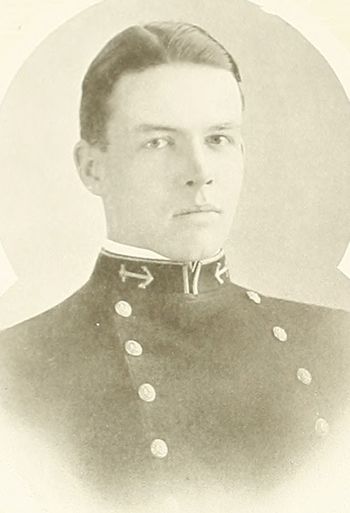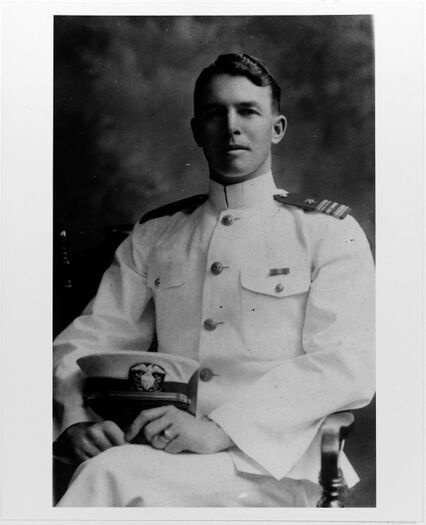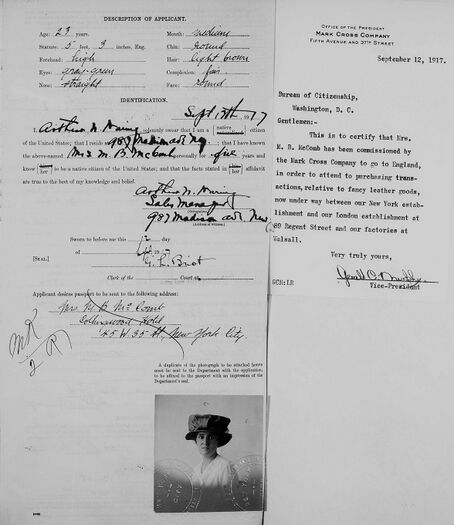MILLINGTON B. MCCOMB, LCDR, USN
Millington McComb '10
Lucky Bag
From the 1910 Lucky Bag:
Millington Barnett McComb
Haddonfield, New Jersey
"Mac," "Parson"
A sailor and preacher they say,
Is not to be found now-a-day;
But look at McComb
And then you must own
That such leads the Y. M. C. A.
JERSEY Scotchman, with ministerial instincts, sea-going habits, an artistic temperament and bow legs! As president of the Y. M. C. A. he used common sense in selecting his entertainers and speakers—"Bells" excepted—and as a result had a greater attendance at his meetings than ever before. As a sailor he did good work in class and company races, and had a standing req. in for the Argo First Class spring. For his artistic temperament one has only to glance through these pages. Mac is the kind of man who, in drawing a battleship, will draw its anchor chain, put links in the chain, then put studs in the links, and finally mourn because he can't put B. N. Y. on each stud!
He is one of the very few men in the Class who have kept to one roommate for four long years, and truly he and Steenwhacker are a great pair. It is sometimes all the Dutchman can do, too, to hold down the erratic Parson when he goes off on one of his various tangents. At Northfield, in charge of the delegates, and carrying all the tickets, he left one train early, without telling a soul of his intentions.
A steadfast man, he has lived up to his principles for four years in a place where principles usually last about four days.
President Y.M.C.A. Fencing Squad (4, 3, 2). Rifle Squad (2). Sharpshooter (2). Christmas Card Committee (3, 2, 1). Northfield Delegate (1)

Millington Barnett McComb
Haddonfield, New Jersey
"Mac," "Parson"
A sailor and preacher they say,
Is not to be found now-a-day;
But look at McComb
And then you must own
That such leads the Y. M. C. A.
JERSEY Scotchman, with ministerial instincts, sea-going habits, an artistic temperament and bow legs! As president of the Y. M. C. A. he used common sense in selecting his entertainers and speakers—"Bells" excepted—and as a result had a greater attendance at his meetings than ever before. As a sailor he did good work in class and company races, and had a standing req. in for the Argo First Class spring. For his artistic temperament one has only to glance through these pages. Mac is the kind of man who, in drawing a battleship, will draw its anchor chain, put links in the chain, then put studs in the links, and finally mourn because he can't put B. N. Y. on each stud!
He is one of the very few men in the Class who have kept to one roommate for four long years, and truly he and Steenwhacker are a great pair. It is sometimes all the Dutchman can do, too, to hold down the erratic Parson when he goes off on one of his various tangents. At Northfield, in charge of the delegates, and carrying all the tickets, he left one train early, without telling a soul of his intentions.
A steadfast man, he has lived up to his principles for four years in a place where principles usually last about four days.
President Y.M.C.A. Fencing Squad (4, 3, 2). Rifle Squad (2). Sharpshooter (2). Christmas Card Committee (3, 2, 1). Northfield Delegate (1)
Loss
Millington was lost on November 26, 1927 "as result of an aircraft accident" in or near Pearl Harbor, Hawaii, while he was commanding officer of the Naval Air Station there.
Other Information
From researcher Kathy Franz:
In his youth, Millington went by his middle name Barnett. In June 1902, he and his brother Robert went on a picnic to Riley’s wood with others from the 1902 and 1903 classes of Haddonfield high school. Their proposed boating trip was cancelled when it began to rain. They took up their festivities at a house in town. Millington graduated from the high school in June, 1903.
Millington’s parents were active in the Y and at the Presbyterian church. They held Y meetings and debates at their home. In November 1904 the question for discussion was “Resolved, that the licensed liquor traffic can be stopped only by the Prohibition party.”
Millington was named first alternate to the Naval Academy by Congressman Loudenslager in March, 1904. Millington failed on certain studies after he had been at the Academy for a time. He was reappointed as principal to the Naval Academy by Congressman Loudenslager in March, 1906.
In October 1909 the Naval Academy Bulletin was a weekly publication. Millington was on the staff and was the Young Men’s Christian Association editor. Millington was the assistant art editor on the 1910 Lucky Bag.
From The Baltimore Sun, April 30, 1910:
Annapolis, Md., April 29 – If weather conditions are favorable tomorrow morning, a yacht race with promises to be interesting will be sailed in Chesapeake Bay in the vicinity of Annapolis. The boats in the race will be the yachts Argo and Robert Centor, of the Naval Academy mosquito fleet. They will be manned by crews picked from the two battalions of the brigade of midshipmen. The skipper of the Argo will be Millington B. McComb, of New Jersey, while the Robert Centor will be captained by Robert T. Merrill, of Rhode Island. Both are first class men.
From The Baltimore Sun, May 1, 1910:
Annapolis, Md., April 30. – Chesapeake bay in the vicinity of Severn river was the scene this afternoon of an exciting yacht race, when the Argo and the Robert Centor, of the mosquito fleet attached to the Naval Academy, got together, the crews manning them being picked from the two battalions of the brigade of midshipmen. Though the Argo defeated her rival, the race was an interesting one. The Argo was captained by Midshipman Millington B. McComb, of New Jersey, and the skipper of the Robert Centor was Robert T. Merrill, of Rhode Island.
The race was over a triangular course, beginning at Green-Berry Point Light, inside the Severn, thence to Thomas Point, to Sandy Point and return, a distance of about 18 miles. A spanking good breeze was blowing and for the first half of the contest, the stretch, the boats kept pretty well together, but after that the Argo steadily crept to the front and finished nearly a mile to the good. Her time was 3 hours 7 minutes.
Both of the boats are schooner-rigged, but the Argo is built along more modern lines than her rival and is capable of carrying a greater amount of canvas. The boats were manned by crews of 15 each.
Millington married Grace Stewart Ewing on April 17, 1917, at her sister’s home in Lunenburg, Massachusetts. Grace was secretary of the class of 1918 at Wellesley. In September, Grace received her passport to travel to England on commercial business for the Mark Cross company. She reached England safely in October. She expected to do war relief work and be near her husband when he came in from his convoying cruises.
Grace offered her services to the American Red Cross and was sent to France. In October 1918, she was quoted in many newspapers as saying, “So urgent is the need for trained nurses in France that nurses’ aids, just two weeks overseas, have been given the management of entire wards in French hospitals in order to release the ward nurses for use in the operating rooms. The need for American nurses, especially in the operating rooms, is desperate, and those already in France are working beyond their strength. While there is work to do they will not stop. They cannot go on forever, and it is obvious that unless nurses are supplied to take their places, so that they will be given a chance to rest and regain their strength, they will go to pieces.”
She told of one aid loaned by the Rockefeller Institute, who after being but two weeks in France, was given complete charge of a French ward, containing forty-four beds with nineteen patients coming out of ether at one time. The other nurses were being used in the operating rooms. She had only the assistance of one orderly, an old wounded French soldier, whom she herself discovered and put to work.
In Brest, a seaport town of France, a retired French naval officer Admiral Barthe, has himself established a base hospital. The five hundred beds, always occupied, are cared for by his daughter, Alene Barthe, an older woman and one operating nurse. The hospital is in an old monastery that boasts of hundreds of years of history, but scarcely a single sanitary convenience is in evidence. It frequently takes two days for the three women to make the rounds and change the dressings. Much of the treatment of their soldier patients is what is called “healing by first intention” – wounds that show signs of healing are permitted to heal, shrapnel and all, trusting to nature for the rest.
In addition to the Navy Distinguished Service Medal, Millington received the Legion of Honor from the French government for sinking two German submarines while on patrol duty in the North sea.
From The San Francisco Examiner, October 29, 1922:
A plunge into the bay in a navy land plane of the Pacific Fleet Air Squadron early yesterday morning endangered the lives of Lieutenant Commander Millington B. McComb, U. S. N., and Lieutenant J. Dizzemore [Dinsmore] Lowry, [‘19] U. S. N. Their engine went dead 1,000 feet over the Golden Gate after they had taken off from Crissy Field in flight for San Diego.
The plunge was seen by a dozen bay fishing craft, which rushed to the scene and the two officers were dragged to safety from their half submerged plane five minutes after they struck the water.
Buoyant cylinders on the ends of wings brought the airship to the surface with her pilot and passenger suffering no more than a fright and a ducking.
When brought to shore, the navy men declined other attendance than the proffer of dry army uniforms.
The plane was dragged from the bay late yesterday afternoon under the direction of Commander McComb.
Millington was cited for heroism in an airplane accident in 1924 while 20 miles at sea off the coast of San Diego. The engine ailing, he dumped the gasoline supply, thus making the empty tank serve as a buoy. The crew was rescued later by a mine sweeper. Per the Dayton Herald, Ohio, December 12, 1927.
In September 1924 Millington, with cameraman F. M. Fraley aboard, flew outside the heads and accompanied the fleet into the San Francisco harbor. The photos were printed later that day in the “Examiner.” The flight authorization came from Captain Stanford E. Moses (Class of 1892), local head of the naval air forces.
In October, Millington of the V.O. squadron set a time record of 3 hours, 55 minutes flying from Crissy field, Bay City, to San Diego in his De Haviland. The plane had a tail wind of 50 miles an hour that sent him and his passenger Captain Stanford E. Moses through one of the worst hail and snow storms in the mountains north of the Tehachapi. Rain clouds were so low, he flew at lower than 6,000 feet at times.
In September 1925 Millington, lieutenant commander at Pearl Harbor, was making preparations for the arrival of two planes from San Francisco. One plane developed engine trouble and had to turn back. Commander John Rodgers’ PN-9 No. 1 plane ran out of fuel before reaching Hawaii. She was discovered after nine days drifting with Rodgers (’03) and her crew alive and well. They boarded the submarine R-4 for the trip to land. Millington sent them a message that the whole navy is rejoicing and that their families had been notified. Fourteen years earlier, Commander Rodgers learned to fly as a pupil of the Wright brothers at Dayton, Ohio.
Rodgers and his crew left Honolulu on the USS Idaho for San Francisco on the morning of September 17. After the ship got underway, three planes from Pearl Harbor, under the direction of Millington, appeared and circled over her showering yellow paper leis on the ship and the water nearby.
A year later, on September, 18, 1926, in the Honolulu Regatta races, Millington came in first in the sixth race of the day for Star Class Yachts. His time was one hour, 26 minutes and 30 seconds. All the boats finished within five minutes of each other.
Cora M. Roberts wrote a series of articles on Numerology for the Honolulu Star-Bulletin. In the fifth of the series, she analyzed Millington’s name and his birthdate. She concluded that “He has a splendid name in every way, universal love, student mind, genius, practicality, tact, and gentleness. What more could one want?” (published March 20, 1926.)
In April 1927 Millington and his wife won the star boat race in Honolulu.
On November 26, Millington and another plane piloted by Lieut. Roland P. Kauffman (’22) were escorting the steamer Malolo out of Honolulu harbor for its trip to San Francisco. Both planes had turned back, and Millington’s plane, a two-seated Voight plane with mechanic I. C. Anthony aboard, plunged into the sea off Koko head. Reports from the Malolo indicated that one wing of the plane broke off cleanly, and that someone jumped. It is presumed Anthony was killed after jumping. Millington was cremated, and his wife and three sons brought his ashes home on the Malolo in December.
Grace moved the family to New Jersey and then got a job in Washington, D. C. She remarried William Smith, II, manager of the Smith cough drop company in Poughkeepsie, New York.
Millington and Grace’s sons all served in WWII. Peter was a naval reserve ensign, Donald did submarine service, and Arthur was a Navy lieutenant (jg.) Donald became an architect in Poughkeepsie and died in 1993. Arthur was a factory traffic manager in 1950 and later was a stockbroker. In 1990, he was named YMCA “Volunteer of the Year” having 35 years of service to the YMCA. He had visited the camp Wa Wa Segowea when he was 12 and worked toward its reopening in 2009.
In the 1900 census of Haddonfield, Millington’s father was Arthur M. and his mother was Mary E. (Barnett.) His sisters were twins Ruth and Laura, Judith, and Jessie Annette. Laura married Rev. Hugo Muller and did mission work in Persia in 1922. His brothers were Robert Cooper, who became an electrical engineer for General Electric, and Kemper, who became a clergyman. In 1944, Kemper was executive secretary of the Church federation and was instrumental with others in opening government housing projects to Japanese Americans in Dayton, Ohio.
He is buried in Arlington National Cemetery.
Photographs
From Hall of Valor:
The President of the United States of America takes pleasure in presenting the Navy Distinguished Service Medal to Lieutenant Commander Millington Barnett McComb, United States Navy, for exceptionally meritorious service in a duty of great responsibility as Commanding Officer of the U.S.S. CHRISTABEL, engaged in the important, exacting and hazardous duty of patrolling the waters infested with enemy submarines and mines, in escorting and protecting vitally important convoys of troops and supplies through these waters, and in offensive and defensive action, vigorously and unremittingly prosecuted, against all forms of enemy naval activity; and especially for an engagement with an enemy submarine on 21 May 1918, as a result of which the convoy under escort of the CHRISTABEL was protected and the submarine so completely disabled that she was compelled to intern at Santander, Spain, for the remainder of the war.
General Orders: Authority: Navy Book of Distinguished Service (Stringer)
Service: Navy
Division: U.S.S. CHRISTABEL
World War I Service
He was commanding officer of USS Christabel (No. 162), a converted yacht, in the first half of 1918 (see below). Later, he was commissioning commanding officer of USS Craven (Destroyer No. 70).
The "Register of Commissioned and Warrant Officers of the United States Navy and Marine Corps" was published annually from 1815 through at least the 1970s; it provided rank, command or station, and occasionally billet until the beginning of World War II when command/station was no longer included. Scanned copies were reviewed and data entered from the mid-1840s through 1922, when more-frequent Navy Directories were available.
The Navy Directory was a publication that provided information on the command, billet, and rank of every active and retired naval officer. Single editions have been found online from January 1915 and March 1918, and then from three to six editions per year from 1923 through 1940; the final edition is from April 1941.
The entries in both series of documents are sometimes cryptic and confusing. They are often inconsistent, even within an edition, with the name of commands; this is especially true for aviation squadrons in the 1920s and early 1930s.
Alumni listed at the same command may or may not have had significant interactions; they could have shared a stateroom or workspace, stood many hours of watch together, or, especially at the larger commands, they might not have known each other at all. The information provides the opportunity to draw connections that are otherwise invisible, though, and gives a fuller view of the professional experiences of these alumni in Memorial Hall.
January 1911
January 1912
January 1913
January 1914
January 1915
January 1916
January 1917
March 1918
January 1919
January 1920
January 1921
January 1922
May 1923
July 1923
September 1923
November 1923
January 1924
March 1924
May 1924
July 1924
September 1924
November 1924
January 1925
March 1925
May 1925
July 1925
October 1925
January 1926
October 1926
January 1927
April 1927
October 1927

The "category" links below lead to lists of related Honorees; use them to explore further the service and sacrifice of alumni in Memorial Hall.

